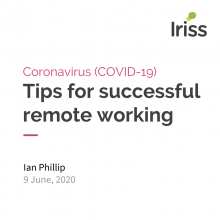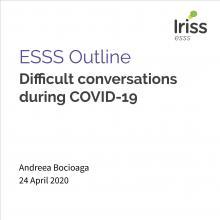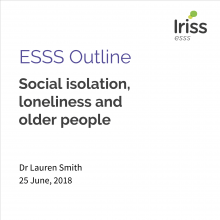Introduction
This summary provides an overview of recent evidence relating to:
Covid-19, social isolation and loneliness.
About the evidence presented below
We searched for academic research and grey literature using a wide range of search terms including: social isolation, effects of social isolation, social exclusion, loneliness, isolation, social connections, social distancing, mental health and Covid-19.
While there is a spread of literature discussing isolation and loneliness - and the mental and physical effects it they have, particularly around older people - the quality of evidence for the majority of interventions is generally weak.
While the Covid-19 pandemic and the resulting lockdown is a new phenomenon for the UK there are studies from isolated, confined and extreme (ICE) environments, and from other pandemics around the world.
Accessing resources
We have provided links to the materials referenced in the summary. Some materials are paywalled, which means they are published in academic journals and are only available with a subscription. Some of these are available through the The Knowledge Network with an NHS Scotland OpenAthens username. The Knowledge Network offers accounts to everyone who helps provide health and social care in Scotland in conjunction with the NHS and Scottish Local Authorities, including many in the third and independent sectors. You can register here. Where resources are identified as ‘available through document delivery’, these have been provided to the original enquirer and may be requested through NHS Scotland’s fetch item service (subject to eligibility).
Where possible we identify where evidence is published open access, which means the author has chosen to publish their work in a way that makes it freely available to the public. Some are identified as author repository copies, manuscripts, or other copies, which means the author has made a version of the otherwise paywalled publication available to the public. Other referenced sources are pdfs and websites that are available publicly.
Background
A major adverse consequence of the Covid-19 pandemic is likely to be increased social isolation and loneliness. A general population survey (Ipsos MORI, 2020) revealed widespread concerns about the effects of social isolation and distancing, including increased anxiety, depression, stress, and other negative feelings (Holmes, 2020).
Both of these can have a detrimental effect on health and wellbeing under normal circumstances. This risk is greater for some than others, and as is often the case, it’s those who are already vulnerable.
The literature tells us is that anyone can experience social isolation and loneliness at some stage in their life, and the pandemic is occurring against the backdrop of increased prevalence of loneliness and mental health issues in the UK (Holmes, 2020). Research suggests people already lack social connections.
Loneliness is part of the web of social exclusion - living alone and / or without children, poor health, no access to transport, not owning your home, low income, no phone, and old age. Social and community policies have struggled to grasp these complex interlocking problems (Age UK, 2012).
If we already live in a time when it’s argued loneliness is itself an epidemic then financial insecurity, the death of a friend or family member and being in poorer health can only worsen this.
When the solution to loneliness and isolation is often more human connection, then action is needed to mitigate the mental, emotional and physical health consequences of people compelled to remain at home, avoiding contact with friends, family and the wider public (Armitage, 2020).
Defining loneliness and social isolation
The terms are separate, but often used interchangeably, and made complicated because it’s possible for a person to feel lonely but not to be socially isolated, and be socially isolated without feeling lonely (Welsh Government, 2019; BGS, 2019).
In 2003 (SPHN, 2017) Public Health England defined:
- social isolation as an absence of social interactions, social support structures and engagement with wider community activities or structures
- loneliness as an individual’s personal, subjective sense of lacking connection and contact with social interactions to the extent that they are wanted or needed
The Scottish Government (2018) defined social isolation around the quality and quantity of the social relationships a person has at individual, group, community and societal levels. Loneliness is a subjective feeling experienced when there is a difference between an individual's felt and ideal levels of social relationships.
There is arguably a large overlap between social isolation and loneliness (Golden, 2009), with social isolation being one of the biggest predictors of subjective loneliness, and both having negative effects on health and wellbeing.
In the context of Covid-19, social isolation includes avoiding social contact with family and friends, organising the delivery of essential items, where social contact is to be maintained at a distance of two metres (Brooke, 2020).
Those at risk
Social isolation and loneliness can affect all members of society, including families and younger people, so there is no typical profile of someone at risk (NHS Health Scotland, 2018). Patterns are not equally distributed across the population but based on the available data, children and adults who are socio-economically disadvantaged, those living alone, widowed or separated, and people in poor physical and mental health are at particular risk.
An ONS analysis (2018) highlighted three profiles of people at particular risk from loneliness:
- Widowed older homeowners living alone with long-term health conditions
- Unmarried, middle-agers with long-term health conditions
- Younger renters with little trust and sense of belonging to their area.
With the current situation, where people are advised to avoid social activities, non-essential travel, and unnecessary visits to relatives or friends, where employment, housing and personal finances are precarious, there is a risk that health and wellbeing and feelings of connectiveness will deteriorate further (Brooke, 2020).
Older people
Older people can be more vulnerable to being lonely (and living alone) with declining social circles, deteriorating health, death of partners and friends (Victor, 2012). And certain sub-populations such as older people within the gay, lesbian and bisexual community and immigrants are even more vulnerable (American Psychological Society, 2020).
Considered alongside the current Covid-19 social restrictions, the impact of disrupted social care services, the ageist discourse, and devaluing of older people contributing to feelings of worthlessness, of being a burden, older people are particularly vulnerable (Brooke, 2020).
Self-isolation will disproportionately affect older people whose only social contact is out of the home, such as shopping, daycare and community centres and places of worship. Those who do not have close family or friends, and rely on the support of voluntary services or social care, who are already lonely, isolated, or secluded, face further barriers to contact (Armitage, 2020).
People in institutional settings
Older people in residential care homes are at risk of becoming more socially isolated due to visiting restrictions. Generally people living in institutional settings - care and residential homes, assisted living facilities, prisons and jails - are already cut off from many parts of society and further susceptible to loneliness and isolation (The Hill, 2020).
Rural areas
Rural areas, already facing barriers to countering social isolation and loneliness, including transportation, and limited internet and mobile access, are likely to struggle further with older populations and spread health and care resources (The Hill, 2020).
Contributing factors
What are normally contributing factors to social isolation and loneliness have almost certainly been exacerbated by the coronavirus, and the resulting shutdown and social isolation. The Scottish Government (2018) highlighted 4 themes which featured prominently in their earlier analysis of social isolation: transportation, housing, public spaces and digital technology.
A recent study looking at the UK, US and Japan (KFF, 2018) found a number of differing societal factors and views on what contributes to loneliness and social isolation, including unemployment, increased use of technology, adults playing less of a role in helping ageing parents, people moving away from where they grew up, and cuts in government social programs.
The effects
Social isolation and loneliness are risk factors for poor mental and physical health (Santini, 2020). A study (Steptoe, 2013) highlights isolation as one of the main risk factors that worsen pre-existing conditions, comparable to smoking. Meta-analysis research has found that feeling lonely, being physically isolated or living alone were each associated with a risk of early death (Holt-Lunstad, 2015).
The KFF study (2018) pointed to poor habits developing, with people overeating, smoking or using alcohol and drugs more when lonely and isolated.
Prior to Covid-19 this was acknowledged in health and social care policies and campaigns. The Campaign to End Loneliness created a network of national, regional and local organisations to work together to ensure that loneliness of older people remains a public health priority (Brooke, 2020)
Physical health
In meta-analyses, they are associated with a 50% increased risk of developing dementia, around 30% increased risk of incident coronary artery disease or stroke, and a 26% increased risk of all-cause mortality (Donovan, 2020; Armitage, 2020).
One of the immediate issues around social isolation is the reduction in physical activity and greater sedentary time, which can impact on mobilit and contribute to increased risk of frailty, ill-health and poor wellbeing, particularly for older people (CEBM, 2020; Schrempft, 2019; BGS, 2019).
Mental health
Loneliness and social isolation can be the catalyst for many mental health problems, including acute stress disorders, irritability, insomnia, emotional distress, mood disorders, including depressive symptoms, fear and panic, anxiety, frustration and boredom, loneliness, self-harm, suicide, substance abuse (Holmes, 2020; Donovan, 2020; Brooks, 2020; Desclaux, 2017).
People with severe mental illness are already likely to be affected by social isolation and other social issues compounding their vulnerability such as homelessness, loneliness and poorer physical health (Usher, 2020).
Studies on social isolation associated with quarantine and ICE can give some insight into how social isolation can affect individuals (The Psychologist, 2020). Both populations will experience periods of monotony and boredom, suffer from low mood and motivation, and need to tolerate being in close proximity to a small number of other people, or being separated from friends and family for long periods of time.
The paper highlights key areas:
- Adapting to social isolation and quarantine disrupts a person’s normal way of life. Establishing a routine can help.
- The uncertainty of not knowing what lies ahead can lead to feelings of anxiety and fear. Focus on the most important, achievable, and immediate tasks - what can be done over the next hour, day or week.
- As isolation and quarantine measures continue, monotony and boredom will likely set in. For those with means there is a wide range of internet-enabled entertainment and distractions. Those without this access will struggle.
- It is highly likely that people will experience feelings of low mood and a lack of motivation. Ways of coping with low mood and motivation in ICE conditions include acknowledging progress and focusing on small achievements to help foster a sense of competence.
Many of these methods of coping can rely on the use of technology, or interaction with other people, which creates difficulties for those already lonely or isolated.
The longer a person is confined to quarantine, the poorer the mental health outcomes. Symptoms of posttraumatic stress disorder, avoidance behaviour and anger may be seen (Brooke, 2020). The mental health impacts often continue beyond the quarantine period.
The reciprocal connections between loneliness and any Covid-19 responses may be crucial to mental health (Okruszek, 2020). Pandemic conditions, repeated media consumption and constant health messaging around Covid-19 can have an exacerbating effect on the mental health of those in isolation (Holmes, 2020).
How can they be mitigated under current conditions?
The Scottish Government’s (2018) consultation responses on social isolation highlighted policies and regulation, sustainable funding, education and training, and designing and delivering support.
Although they’re often seen as interchangeable, social isolation and loneliness are distinct and might represent different risk pathways. Tracking and intervening in both should be a priority. And as individuals forced to stay at home may have little control over any mitigators it’s crucial they are addressed by medical professionals, government leaders, decision-makers and advisors, and effective strategies identified to deal with the psychological demands of isolation (The Psychologist, 2020).
Brooks (2020) suggests the experience should be made as tolerable as possible for people by:
- explaining what is happening, why and how long it will continue
- providing meaningful activities for them to do while in quarantine
- providing clear communication
- ensuring basic supplies (such as food, water, and medical supplies) are available
- reinforcing the sense of altruism that people should be feeling
Holmes (2020) identifies:
- Immediate interventions - determine the best ways of signposting and delivering mental health services for vulnerable groups, including online clinics and community support. Find evidence-based interventions that can be rapidly scaled up. Identify gaps requiring bespoke remotely delivered interventions.
- Long term interventions - from the gaps identified, design bespoke approaches for population-level interventions targeted at the prevention and treatment of mental health symptoms (e.g. anxiety) and at boosting coping and resilience (e.g. exercise). Develop innovative interventions from experimental and social sciences (e.g. for loneliness consider befriending) that can help mental health; assess the effectiveness of arts-based and life-skills based interventions and other generative activities including exercise outdoors.
The emphasis on creating opportunities to bring people together, maintaining and creating networks and friendships, and promoting activities to support those who are lonely and socially isolated (SCIE, 2018) may not be appropriate during the Covid-19 shutdown, or need to be adapted.
CEBM (2020) suggests social prescribing, mutual aid and community care programmes are still relevant for maintaining community connectedness, despite distancing and isolation.
Findings from an Italian survey (Barasi, 2020) suggests support designed to reduce the boredom of long term social isolation and increase the attractiveness of following public health recommendations. The paper highlights the need for interventions that make isolation more desirable, such as virtual social interactions, online social reading activities, classes, exercise routines.
They also recommend that public awareness campaigns focus on ways on making the quarantine easier and more frictionless, rather than repeating the reasons to stay indoors.
Current guidance in the UK states the importance of staying connected and getting practical help, but often offers no advice on how to do this (Brooke, 2020)
Membership organisations such as the British Geriatrics Society and charity and third sector organisations like Age Scotland suggest measures for the public to support people who are self-isolating including:
- Offering to go shopping, pick up medication
- Setting up regular phone calls with isolated friends, neighbours and family
- Setting up and helping older people use technology to enable them to have video calls or communicate online
- Encouraging people who are well enough to stay active indoors or go for walks
- Befriending services
- Encouraging older people to pursue hobbies they can do from home such as writing, art, reading, organising photos, crafting or puzzles
- Make sure people have plenty of entertainment such as books, magazines or puzzles
- Helping with pets
- Signposting services available in your area from local councils, charities and other organisations
What works?
The quality of evidence for the majority of interventions for social isolation and loneliness is generally weak. Factors associated with the most effective interventions included adaptability, a community development approach, and productive engagement. Further research is required (Gardiner, 2018; NIHR, 2015; Iriss, 2014).
There have been few randomized controlled trials of interventions for loneliness and social isolation interventions. A recent review and synthesis of the literature (Donovan, 2020) recommended that future interventions should:
- specifically target socially isolated and/or lonely individuals
- have a sound theoretical basis
- utilise established therapeutic approaches with trained facilitators
- Involve active participation of the older adult
Current studies
There are a number of studies in progress looking at the effects of Covid-19 on mental health.
UCL (2020) has launched a study into the psychological and social effects of Covid-19 in the UK. Researchers are aiming to recruit a large sample of adults living in the UK to help understand the effects of coronavirus and social distancing measures on individuals. The data will help them track trajectories of mental health and loneliness in the UK by identifying which groups are most at risk and to understand the effects of any potentially protective activities people could be engaging in.
Glasgow University’s Institute of Health and Wellbeing is overseeing the largest nationally representative survey of the adult population’s response to the crisis. Interim findings are expected soon, with researchers hoping to gain an impression of the impact of lockdown, along with indications about the groups of people who need immediate support (Guardian, 2020).
Much of the support offered is likely to be digital while physical distancing continues, raising two important concerns, will these digital approaches be evidence based, and what will the impact be on the already digitally excluded?
Digital exclusion
From a health and social care perspective support can come virtually. Community responses have included the development of support groups and social networks through online platforms such as Facebook, Twitter, Skype and WhatsApp, and apps such as Nextdoor. Entertainment comes from film and music streaming services, virtual concerts, museum and gallery tours. But all require internet access and a device on which to use it.
The socially isolated and economically disadvantaged already tend to have no, or more limited access to and use of the internet, devices and online services (Iriss, 2020). In 2018, 8% of people in the UK (4.3 million people) were estimated to have zero basic digital skills. A further 12% (6.4 million adults) were estimated to only have limited abilities online (missing at least one of the basic digital skills) (ONS, 2019). So as schools, workplaces, socialising, shopping and accessing key services - such as banking, government and council services - have all increasingly moved online, more people will be left out.
And for those already isolated or lonely there’s an increasing risk of it being exacerbated as current responses to alleviate the social distancing, isolation and loneliness are often digital or technology based.
So policy recommendations such as distributing tablets or laptops to ensure the whole population has online capabilities (Barari, 2020) or can home study are necessary as the lockdown continues. Some of which is taking part already in Scotland, with the Simon Community, for example, providing laptops and mobile phones to connect with and support homeless people (ALLIANCE, 2020).
References
Age UK (2012) Loneliness - the state we’re in (pdf)
ALLIANCE (2020) Supporting homeless people through COVID-19 (website)
American Psychological Society (2020) COVID-19 isn’t just a danger to older people’s physical health (website)
Armitage, R and Nellums, LB (2020) COVID-19 and the consequences of isolating the elderly The Lancet (open access)
Barari, S (2020) Evaluating COVID-19 Public Health Messaging in Italy: Self-Reported Compliance and Growing Mental Health Concerns (pdf)
BGS (2019) Position statement on loneliness and social isolation (pdf)
BGS (2020) Coronavirus: Advice to older people, families, friends and carers (website)
Brooke, J and Jackson, D (2020) Older people and COVID‐19: Isolation, risk and ageism J Clin Nurs (open access)
Brooks (2020) The psychological impact of quarantine and how to reduce it: rapid review of the evidence The Lancet volume 395, issue 10227, p912-920, march 14 (website)
CEBM (2020) Maximising mobility in older people when isolated with COVID-19 (website)
Cohen-Mansfield, J (2016) Correlates and predictors of loneliness in older-adults: A review of quantitative results informed by qualitative insights International Psychogeriatrics, 28(4), 557-576 (paywall)
Desclaux, A et al (2017) Accepted monitoring or endured quarantine? Ebola contacts' perceptions in Senegal Social Science & Medicine, Volume 178, Pages 38-45 (open access)
Donovan, NJ (2020) Timely Insights Into the Treatmentof Social Disconnection in Lonely, Homebound Older Adults The American Journal of Geriatric Psychiatry (pdf)
Gardiner, C (2018) Interventions to reduce social isolation and loneliness among older people: an integrative review Health Soc Care Community, 26: 147-157 (open access)
Golden, J (2009) Loneliness, social support networks, mood and wellbeing in community-dwelling elderly International journal of geriatric psychiatry. 24. 694-700 (open access)
The Guardian (2020) Concern for Britons feeling trapped and lonely during lockdown (website)
The Hill (2020) COVID-19 poses an unequal risk of isolation and loneliness (website)
Holmes, EA (2020) Multidisciplinary research priorities for the COVID-19 pandemic: a call for action for mental health science Lancet Psychiatry (pdf)
Holt-Lunstad, J (2015) Loneliness and social isolation as risk factors for mortality: a meta-analytic review Perspect Psychol Sci. 2015 Mar;10(2):227-37 (paywall)
Ipsos MORI (2020) COVID-19 and Mental Wellbeing (website)
Iriss (2014) Preventing social isolation and loneliness in older people (pdf)
Iriss (2020) Digital inclusion, exclusion and participation (website)
Jones, XR (2020) Covid-19: An Exposition,with a Focus on Social Isolation in the Elderly (UK) (pdf)
KFF (2018) Loneliness and Social Isolation in the United States, the United Kingdom, and Japan:An International Survey (pdf)
Leigh-Hunt, N (2017) An overview of systematic reviews on the public health consequences of social isolation and loneliness Public Health, Volume 152, 2017, Pages 157-171 (open access)
McCann, A (2017) Social Isolation & Loneliness: What is the Scope for Public Health Action? Scottish Public Health Network (pdf)
NHS Health Scotland (2018) Social isolation and lonelinessin Scotland: a review ofprevalence and trends (pdf)
NIHR (2015) Health and wellbeing consequences of social isolation and loneliness in old age (pdf)
Okruszek, L (2020) Safe but Lonely? Loneliness, Mental Health Symptoms and COVID-19 PsyArXiv, 10 Apr (open access)
ONS (2018) Loneliness - What characteristics and circumstances are associated with feeling lonely? (website)
The Psychologist (2020) Coping with life in isolation and confinement during the Covid-19 pandemic (website)
Santini ZI (2020) Social disconnectedness, perceived isolation, and symptoms of depression and anxiety among older Americans (NSHAP): a longitudinal mediation analysis Lancet Public Health. 2020;5(1):e62–e70 (open access)
Schrempft, S (2019) Associations between social isolation, loneliness, and objective physical activity in older men and women BMC Public Health 19, 74 (open access)
SCIE (2018) Tackling loneliness and social isolation: the role of commissioners (website)
Scottish Government (2018) Tackling social isolation and loneliness: consultation analysis (pdf)
SPHN (2017) Social Isolation & Loneliness: What is the Scope for Public Health Action? (pdf)
Steptoe, A (2013) Social isolation, loneliness, and all-cause mortality in older men and women Proc Natl Acad Sci USA. 2013;110(15):5797–5801 (open access)
UCL (2020) New study into psychological and social effects of Covid-19 (website)
Usher, K (2020) Life in the pandemic: Social isolation and mental health J Clin Nurs (pdf)
Victor, CR and Bowling, A (2012) A Longitudinal Analysis of Loneliness Among Older People in Great Britain The Journal of Psychology, 146:3, 313-331 (paywall)
Welsh Government (2019) Review of the impact of loneliness and social isolation on health and well-being and whether people who experience loneliness / social isolation have higher use of public services (pdf)
Suggested reference: Sanders, R (2020) ESSS Outline: Covid-19, social isolation and loneliness. Iriss. https://doi.org/10.31583/esss.20200422









